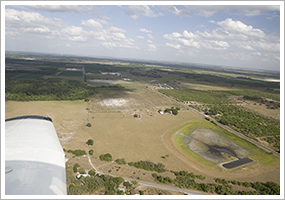This is the custom content for the September 3, 2010, issue of 'AOPA ePilot' e-newsletter.
| The following stories from the September 3, 2010, edition of AOPA ePilot were provided to AOPA members who expressed an interest in the particular subject areas. Any AOPA member can receive information tailored to their areas of interest by updating their preferences online. |
training tipsThe off-airport landing
The CFI’s “nagging” will have been beneficial if it taught you to be constantly on the lookout for off-airport landing sites while flying. That’s also good prep for the emergency approach and landing task on the private pilot practical test. Two of the seven elements of that task are selecting a “suitable landing area” and planning and following a flight pattern to the area that considers “altitude, wind, terrain, and obstructions.”
In some situations you can take some time deciding where to land—a better plan than sticking with an initial poor selection. Certain hazards, such power lines across your glide path, may not be visible right away, as discussed in the Nov. 7, 2008, “ Training Tip: Power lines.” Chapter 16 of the Airplane Flying Handbook offers this approach to selecting a suitable landing area when there is time to make choices: “If the emergency starts at a considerable height above the ground, the pilot should be more concerned about first selecting the desired general area than a specific spot. Terrain appearances from altitude can be very misleading, and considerable altitude may be lost before the best spot can be pinpointed. For this reason, the pilot should not hesitate to discard the original plan for one that is obviously better. However, as a general rule, the pilot should not change his or her mind more than once; a well-executed crash landing in poor terrain can be less hazardous than an uncontrolled touchdown on an established field.”
Think about the conditions for an emergency off-airport landing when planning routes for your night flights (as discussed on the Flight Training website). Take some time to review the AOPA Air Safety Foundation’s Emergency Procedures Safety Advisor while you’re at it.
Admiring the view while cruising along is one of aviation’s thrills. Go ahead—but survey the details below to be ready for that off-airport landing that you’ll probably never have to make. training productsApp transforms iPhone to flight recorderWant to track your flights and check your flying after the lesson? With an iPhone and a viewer, you can do exactly that. Flyvie has released Flyvie Lite 4, a free iPhone app for recording flights. Flyvie records a live video stream, cockpit audio, and GPS during your flight; review whenever you want from anywhere with Internet access. The application is a free download from iTunes. A yearly subscription to the Flyvie Flight Viewer is $98. The optional iPhone installation kit, which includes a hands-free mount, audio cable, Velcro straps, and a carrying bag, is $60 (shipping included). For more information, see the website.
Note: Products listed have not been evaluated by ePilot editors unless otherwise noted. AOPA assumes no responsibility for products or services listed or for claims or actions by manufacturers or vendors. final exam
Question: What does the term “mode C veil” mean?
Answer: “Mode C veil” refers to an area around an airport in Class B airspace in which at least a Mode C capable transponder is required. According to Federal Aviation Regulation 91.215(b)(1), “This requirement (for Mode C transponders) applies to all aircraft in all airspace within 30 nautical miles of an airport listed in Appendix D, section 1 of this part from the surface upward to 10,000 feet MSL.” An exception found in FAR 91.215(b)(3) includes, among others, any aircraft that was not originally certificated with an engine-driven electrical system. For more information on Mode C, see Robert Snow's article, “ Check-in time: How to report to ATC.”
Got a question for our technical services staff? E-mail [email protected] or call the Pilot Information Center, 800/872-2672. Don’t forget the online archive of “Final Exam” questions and answers, searchable by keyword or topic. |
 A good flight instructor can be a bit of a nag at times, such as when he or she inquires more than once during your training flight, “Where would you land if the engine failed right now?” Sometimes after you select a spot, the CFI idles the throttle and commences a simulated emergency landing drill, to be discontinued at a safe altitude once the likely outcome becomes clear.
A good flight instructor can be a bit of a nag at times, such as when he or she inquires more than once during your training flight, “Where would you land if the engine failed right now?” Sometimes after you select a spot, the CFI idles the throttle and commences a simulated emergency landing drill, to be discontinued at a safe altitude once the likely outcome becomes clear.

